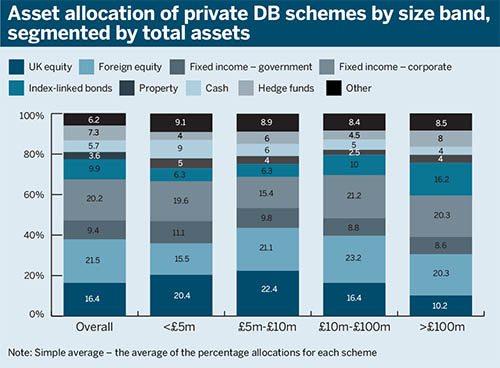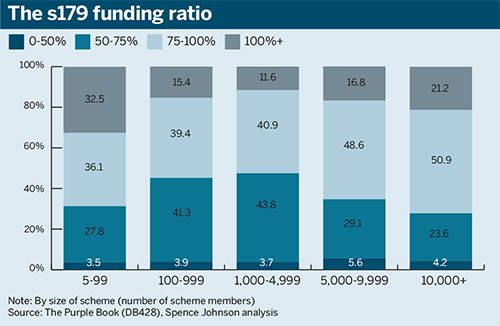Spence Johnson's Magnus Spence asks why small pension schemes, which closed to accrual earlier than their larger peers, are slower to derisk.
This trend was echoed by the fact that many smaller schemes were also a lot faster when it came to opening and populating defined contribution schemes.
You would expect, based on this, that these smaller DB schemes would be deeper into their derisking phases. And you would also expect that they would then show different investment allocations to their larger peers.
In particular you would anticipate smaller schemes growing their use of fixed income and shrinking their use of equity as they approach the end of their lives. But they don’t.
In fact, smaller schemes are, relatively speaking, bigger users of equity and smaller users of fixed income than larger ones. What explains this behaviour?
Small(ish) schemes face a particular problem
On average, and using simple averages so that the very large schemes do not completely dominate the measurement, 40 per cent of DB assets are currently in fixed income, as is shown in the first chart (this rises to 48 per cent when you look at the measure on a weighted basis).

As the chart also shows, the averages vary widely by size category. Schemes with more than £100m in assets allocated an unweighted average of 45 per cent of their portfolios to fixed income, most of these assets invested in index-linked gilts. They invest 30 per cent in equities.
In contrast, the average allocation to fixed income for one particular group of smaller schemes, those with £5m-£10m in assets, is only 32 per cent, significantly less than larger schemes. And they invest 43 per cent in equities, significantly more than larger schemes.
Smaller schemes dive into LDI pools
Smaller schemes are increasingly using liability-driven investment strategies, as the number of pooled mandates powers growth in the market, research from consultancy KPMG has shown.
This group of smaller schemes – the small but not very small – faces a particular problem, and this gives a clue to their investment behaviour. The second chart shows that it is the small but not very small schemes that have the worst funding ratio on a s179 basis.
About 45 per cent of schemes with between 100 and 5,000 members have funding ratios of less than 75 per cent. Schemes both smaller and larger than this group have noticeably better ratios: only about 30 per cent of schemes in these groups have the same severe funding problems.
So the answer to the question – why is it that smaller schemes are, relatively speaking, bigger users of equities, and smaller users of fixed income – is that it is because of funding issues. Many of them may be moving towards closure, but they are not yet able to move into derisking in the traditional sense.

And the key nuance to this answer is that it is not all small schemes that present this picture. Very small schemes, those with fewer than 100 members, reveal the best funding ratios of all. A third of them are in surplus, which simply does not happen anywhere else in the DB world.
Magnus Spence is managing director of Spence Johnson














